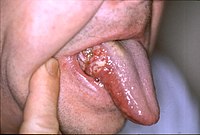
Photo from wikipedia
Different levels of miRNA expression have been described in salivary gland tumors as a potential diagnostic marker and predictor of survival. We systematically reviewed the literature to assess the diagnostic… Click to show full abstract
Different levels of miRNA expression have been described in salivary gland tumors as a potential diagnostic marker and predictor of survival. We systematically reviewed the literature to assess the diagnostic and prognostic value of miRNAs on salivary gland tumors. An electronic search was conducted in PubMed, Scopus, Embase, Cochrane, and Web of Science databases. In the meta-analysis, we assumed random-effects model with adjusted hazard ratio (HR) and 95% confidence intervals (95% CI). For prognostic studies, the risk of bias was assessed by Meta-Analysis of Statistics Assessment and Review Instrument (MAStARI) and Quality Assessment Tool for Diagnostic Accuracy Studies-2 (QUADAS-2) was utilized for diagnostic studies. Gathered data from 1.131 patients in seven studies demonstrated that different levels of miRNA expression presented diagnostic and prognostic in SGTs. The meta-analysis showed that altered miRNA expression were associated with shortened survival (HR, 2.35, 95% CI, 1.77–3.10, P < .00001). For diagnostic meta-analysis, the overall pooled results for specificity and sensibility were 0.87–0.97 (95% CI, 0.72–1) and 0.68–0.91 (95% CI, 0.51–0.96), respectively. MicroRNAs may be useful in prognostication of patients with SGTs; however, the diagnostic value of miRNAs in SGTs is still limited.
Journal Title: Oral and Maxillofacial Surgery
Year Published: 2021
Link to full text (if available)
Share on Social Media: Sign Up to like & get
recommendations!